ETRUSCANS (800-400 B.C.)
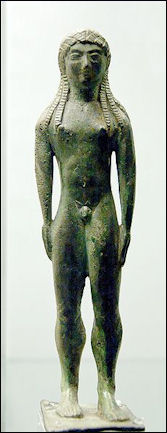 The Etruscans were a mysterious people who resided in a region in east-central Italy slightly north of present-day Rome. They created the first great civilization in what is now Italy, centered in Latium and Tuscany, but left behind a sparse written record so little is known about them except what can be surmised from the pottery and artwork left behind in tombs and the observations of Roman historians. [Source: Rick Gore, National Geographic, June 1988; Dora Jane Hamblin, Smithsonian; Rossella Lorenz, Archaeology, November/December 2010]
The Etruscans were a mysterious people who resided in a region in east-central Italy slightly north of present-day Rome. They created the first great civilization in what is now Italy, centered in Latium and Tuscany, but left behind a sparse written record so little is known about them except what can be surmised from the pottery and artwork left behind in tombs and the observations of Roman historians. [Source: Rick Gore, National Geographic, June 1988; Dora Jane Hamblin, Smithsonian; Rossella Lorenz, Archaeology, November/December 2010]
The Etruscans lived in a loose confederation of towns 3000 years ago in Etruria, a land between the Tiber and Arno rivers mostly in what is now Tuscany and the area north of Rome. Masters of metallurgy and skilled seamen, the Etruscans founded a culture that was very advanced and quite different from other known Italian cultures that flourished at the same time, and highly influential in the development of Roman civilization. At a time when the Romans were just peasant villagers the Etruscans were living in luxurious houses and inscribing documents and filling tombs with gold and silver and imported treasures.
The Etruscans were an agricultural civilization with developed metallurgy that was organized into city-states. They built the first cities in Italy. The Etruscan's have been recognized more for their artistry than their fighting skills. In his misleading portrait of the Etruscans D.H. Lawrence wrote: "How much more Etruscan than Roman the Italy of today is: sensitive, diffident, craving really for symbols and mysteries, able to be delighted with true light over small things, violent spasms, and altogether without sternness or natural will-to-power."
Rossella Lorenz wrote in Archaeology, “They taught the French to make wine and the Romans to build roads, and they introduced writing to Europe, but the Etruscans have long been considered one of antiquity's great enigmas. No one knew exactly where they came from. Their language was alien to their neighbors. Their religion included the practice of divination, performed by priests who examined animals’ entrails to predict the future. Much of our knowledge about Etruscan civilization comes from ancient literary sources and from tomb excavations, many of which were carried out decades ago. But all across Italy, archaeologists are now creating a much richer picture of Etruscan social structure, trade relationships, economy, daily lives, religion, and language than has ever been possible. Excavations at sites including the first monumental tomb to be explored in over two decades, a rural sanctuary filled with gold artifacts, the only Etruscan house with intact walls and construction materials still preserved, and an entire seventh-century B.C. miner's town, are revealing that the Etruscans left behind more than enough evidence to show that perhaps, they aren't such a mystery after all. [Source: Rossella Lorenz, Archaeology, November/December 2010]
Book: The Etruscans by Michael Grant.
History of Etruscans
 The history of the Etruscans extends before the Iron Age to the end of the Roman Republic or from 1200 B.C . to 100 B.C. Many archaeological sites of the major Etruscan cities were continuously occupied since the Iron Age, and the people who lived in the Etruria region did not appear suddenly, nor did they suddenly start to speak Etruscan. Rather they learned to write from their Greek neighbours and thus revealed their language.
The history of the Etruscans extends before the Iron Age to the end of the Roman Republic or from 1200 B.C . to 100 B.C. Many archaeological sites of the major Etruscan cities were continuously occupied since the Iron Age, and the people who lived in the Etruria region did not appear suddenly, nor did they suddenly start to speak Etruscan. Rather they learned to write from their Greek neighbours and thus revealed their language.
The Etruscans first appeared in the historical record around 800 to 750 B.C. There were different from other Italic groups in that spoke a different language. No one knows where they came from and exactly when they arrived. They most likely evolved from Iron Age farmers that already lived in central Italy . Many of their settlements were set up on sites previously occupied by a culture called the Villanovans.
Herodotus theorized the Etruscans originated from Asia Minor, where he said there was great famine in 1200 B.C. According to his account, a great king divided his people in two and asked a leader from each to draw lots. The group that stayed evolved into the Lydians, who remained in western Asia Minor, and the other group left for Italy and became the Etruscans. Archaeologists surmise that there may be some truth to Herodotus's story because of the similarity between Etruscans and Lydian tombs.
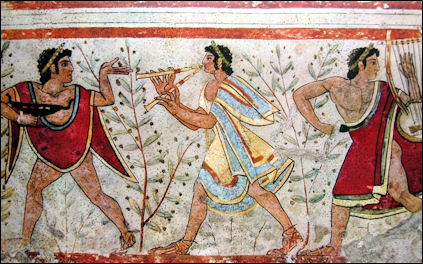 The Etruscans lived on the fringes of the Greek world. Like the ancient Greeks, who prospered about the same time, the Etruscans were organized into independent city states. The large number of Etruscan words borrowed by the Greeks indicates the two civilizatios had been in contact with one another for a considerable amount of time.
The Etruscans lived on the fringes of the Greek world. Like the ancient Greeks, who prospered about the same time, the Etruscans were organized into independent city states. The large number of Etruscan words borrowed by the Greeks indicates the two civilizatios had been in contact with one another for a considerable amount of time.
Etruscan kings ruled Rome from 616 to 509 B.C. The first Etruscan king was Lucius Tarquinius Priscus. Rome's last Etruscan king ascended to the throne in 535 B.C. The Romans threw him out in 509 and replaced the traditional monarchy with a republican government, blaming the king's tyrannical behavior and holding it up as an example of the injustice of authoritarian rule.
The Etruscans were at their height between 600 and 480 B.C. Bronze production reached record levels and trade was conducted throughout the Mediterranean. The Etruscans founded colonies in the Po River Plain between 500 and 400 B.C.. During the fifth and forth centuries B.C., the Etruscans fought with the Romans, with one Etruscan city after another falling to Rome. In 474 B.C. The Etruscan fleet was defeated by Greeks in the battle of Cumae in the Bay of Naples. In 396 B.C., Veii, one of the most important Etruscan city, was sacked after a 12 year siege by the Romans. After the Second Punic War in 202 B.C. the once proud Etruscans were relegated to supplying grain and elements and spears for the Romans. By 90 B.C. they had been absorbed by Rome.
Etruscan Areas in Italy
 Powerful Etruscan cities included Tarquinia, Vulci, Cerveteri, Vertolunia and Veii. Tarquinia was an important Etruscan city that flourished between 600 and 400 B.C. Located about 80 kilometers northwest of Rome, it is the home of a five-kilometer-long necropolis filled with more than 6,000 tombs cut into tufa hills between the 7th and 2nd centuries B.C. The tombs have have yielded much of what we know about the Etruscans.
Powerful Etruscan cities included Tarquinia, Vulci, Cerveteri, Vertolunia and Veii. Tarquinia was an important Etruscan city that flourished between 600 and 400 B.C. Located about 80 kilometers northwest of Rome, it is the home of a five-kilometer-long necropolis filled with more than 6,000 tombs cut into tufa hills between the 7th and 2nd centuries B.C. The tombs have have yielded much of what we know about the Etruscans.
The archeologist Alessando Mandolesi of the University of Turin told Archaeology magazine: Tarquinia “was one of the most powerful cities of the Etruscan league and a wealthy center of trade and commerce. You have to imagine people arriving from the port and seeing the two imposing mounds ...of the Tarquinian rulers." According to Roman tradition Etruscan reached its height when one of its king married a Tarquinian noblewoman and brought a team of painters and artists from Tarquinia to Rome.
Fiesole, Chiusi, Volterra and Populonia were important Etruscan settlements in Tuscany. Fiesole (near Florence) is beautifully situated on a hill overlook the Arno. Here you can find a ruined Etruscan temple, a Roman amphitheater and bath and archeological museum with Roman and Etruscan treasures. Volterra (61 kilometers from Pisa) is situated among hills and crags and boasts an old Etruscan wall and museum.
Umbria also has a number of important Etruscan sites. Underneath Rocca Paolina fortress in Perguria is an underground city and near villa dela Prome is the largest Etruscan arch in Italy. The archeological museum in Tarquina has a fine Etruscan exhibit, including a beautiful pair of winged horses. There are also some excellent tomb painting in the Tarquina area but visitors generally aren't allowed in the tombs. A few miles away is Ipogeo di Volumni there is an interesting Etruscan tomb. There are also Etruscan sights in Todi, Bettona and Orvieto.
Origin of the Etruscans
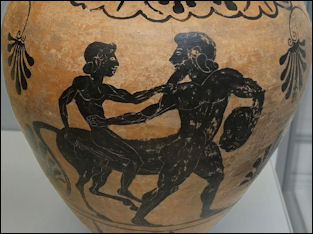 The long-running controversy about the origins of the Etruscan people appears to be very close to being settled once and for all. Professor Alberto Piazza, from the University of Turin, Italy , a geneticist, told a conference of the European Society of Human Genetics that there is overwhelming evidence that the Etruscans were settlers from old Anatolia (now in southern Turkey). [Source: meta-religion.com, June 18, 2007]
The long-running controversy about the origins of the Etruscan people appears to be very close to being settled once and for all. Professor Alberto Piazza, from the University of Turin, Italy , a geneticist, told a conference of the European Society of Human Genetics that there is overwhelming evidence that the Etruscans were settlers from old Anatolia (now in southern Turkey). [Source: meta-religion.com, June 18, 2007]
The origins of the Etruscans have long been debated by archaeologists, historians and linguists. Three main theories have emerged: that the Etruscans came from Anatolia, Southern Turkey, as propounded by the Greek historian Herotodus; that they were indigenous to the region and developed from the Iron Age Villanovan society, as suggested by another Greek historian, Dionysius of Halicarnassus; or that they originated from Northern Europe.
Piazza and his colleagues study genetic samples from three present-day Italian populations living in Murlo, Volterra, and Casentino in Tuscany, central Italy. "We already knew that people living in this area were genetically different from those in the surrounding regions", he says. "Murlo and Volterra are among the most archaeologically important Etruscan sites in a region of Tuscany also known for having Etruscan-derived place names and local dialects. The Casentino valley sample was taken from an area bordering the area where Etruscan influence has been preserved."
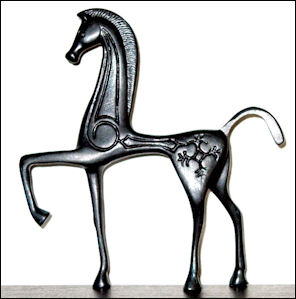 The scientists compared DNA samples taken from healthy males living in Tuscany, Northern Italy, the Southern Balkans, the island of Lemnos in Greece, and the Italian islands of Sicily and Sardinia. The Tuscan samples were taken from individuals who had lived in the area for at least three generations. The samples were compared with data from modern Turkish, South Italian, European and Middle-Eastern populations. "We found that the DNA samples from individuals from Murlo and Volterra were more closely related those from near Eastern people than those of the other Italian samples", says Professor Piazza. "In Murlo particularly, one genetic variant is shared only by people from Turkey, and, of the samples we obtained, the Tuscan ones also show the closest affinity with those from Lemnos."
The scientists compared DNA samples taken from healthy males living in Tuscany, Northern Italy, the Southern Balkans, the island of Lemnos in Greece, and the Italian islands of Sicily and Sardinia. The Tuscan samples were taken from individuals who had lived in the area for at least three generations. The samples were compared with data from modern Turkish, South Italian, European and Middle-Eastern populations. "We found that the DNA samples from individuals from Murlo and Volterra were more closely related those from near Eastern people than those of the other Italian samples", says Professor Piazza. "In Murlo particularly, one genetic variant is shared only by people from Turkey, and, of the samples we obtained, the Tuscan ones also show the closest affinity with those from Lemnos."
Scientists had previously shown this same relationship for mitochondrial DNA (mtDNA) in order to analyse female lineages. And in a further study, analysis of mtDNA of ancient breeds of cattle still living in the former Etruria found that they too were related to breeds currently living in the near East.
Herodotus' theory, much criticised by subsequent historians, states that the Etruscans emigrated from the ancient region of Lydia, on what is now the southern coast of Turkey, because of a long-running famine. Half the population was sent by the king to look for a better life elsewhere, says his account, and sailed from Smyrna (now Izmir) until they reached Umbria in Italy. "We think that our research provides convincing proof that Herodotus was right", says Professor Piazza, "and that the Etruscans did indeed arrive from ancient Lydia.
Etruscan Language
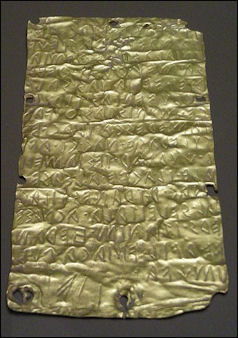
Etruscan tabletThe Etruscans had a written languages but only fragments have been discovered. It was unlike any other language and to this day it remains undeciphered. About 10,000 Etruscans inscriptions have been found, most of them are tomb inscriptions related to funerals or dedicated to gods. They can be "read" in the sense that scholar can make out the specific letters, derived from Greek, but apart from about a few hundred names for places and gods they can not figure out what the inscriptions say.
In 1885 a stele carrying an inscription in a pre-Greek language was found on the island of Lemnos, and dated to about the 6th century B.C. Philologists agree that this has many similarities with the Etruscan language both in its form and structure and its vocabulary.
In 1964, archaeologists found three Rosseta-stone-like gold sheets with Etruscan writing and Phoenician writing in Pygi, Italy. The texts were determined to related to rituals but they failed to add much to the understanding of the Etruscan language. As of 2010, about 300 Etruscan words were known.
Etruscan Religion

Necropolis in SutriEtruscan gods fell into three categories: ones taken from the Greek colonies to the south, ones taken from other Italian cultures and ones they developed themselves. Etruscan religion was dominated by a triad of gods: the precursors of Juno, Jupiter and Minerva. The Etruscans also seemed to be especially interested in gods of the underworld and the afterlife. Gladiator battle were thought to have evolved from Etruscan funerary games.
The Etruscans believed that the will of the gods was manifested through signs in the natural world. The patterns made by flying bird were read for auspicious signs. The word auspicious was originally used to describe a favorable flight of birds. Lightning and thunder were read for symbols of good and bad luck. The future was divined by observing the direction of thunderbolts. Roman leaders called on Etruscan soothsayers to direct lighting bolts at the Visigoths.
The A.D. 1st century Roman historian observed: “This is the difference between us and the Etruscans. We believe that lighting is caused by clouds colliding, whereas they believe that the clouds collide in order to create lightning. Since they attribute everything to the gods. They are led to believe not that events have a meaning because they have happened, but that they happen in order to express a meaning."
Etruscan Liver and Chicken Divination
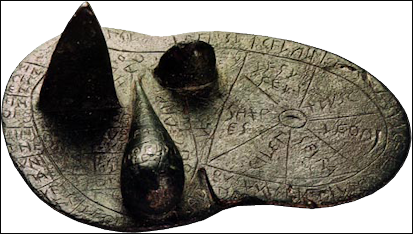
Liver of PiacenzaThe Etruscans used haruspicy (searching for omens in the entrails of animals) to predict the future. Etruscan fortunetellers were famed for their liver reading skills. After a sacrifice the body was opened up and the liver was examined. The liver was divided into region which correspond with the constellations in the sky. The right side denoted good luck and the left side, bad luck. A bronze liver unearthed by archaeologists at Piacenza was divided into forty regions, each marked with name of a different god. ["World Religions" edited by Geoffrey Parrinder, Facts on File Publications, New York]
The custom of breaking a wishbone (the Y-shaped clavicle of a fowl) with a secret wish going to person with the bigger piece has been dated to Etruria in 400 B.C. The Etruscans believed that chickens were soothsayers because they foretold the laying of an egg with a squawk.
A 2nd century B.C. model of a sheep's liver was divided into 16 regions corresponding to sections of the heavens and names of deities. According to the Etruscan "hen oracle," a circle was drawn on the ground with 20 parts, corresponding to letters in the Etruscan alphabet, with pieces of grain in each sector. A sacred chicken was placed in the middle and foretold the future by forming the letters for words by pecking at the grain in the letter's sector.
When the sacred hen died, its bones were dried and the clavicle was stroked before making a wish and thus became known as the wishbone. The clavicle was selected over other bones because its Y-shape had some symbolic meaning. The customs of breaking it for a wish developed in Roman times partly as the result of to many people fighting over one bone.
Etruscan Burials
The Roman custom of displaying the body of the dead, ritual lamentations and hired mourners appears to have originated with the Etruscans. Roman funerary art and architecture and concepts of the afterlife also seem to have also been shaped by the Etruscans.
Etruscans practiced cremation and inhumation. The funeral pyres were often placed near the tomb and offerings and possessions of the dead were often burned along with the body. The remains were placed in terra cotta jars and pots or decorated alabaster and terra cotta chests with effigies or reliefs on the top. These were placed in cylindrical well tombs dug in the rock or earth. A variety of food stuffs and grave goods were buried with the dead. An urn with cremation remains of women found in a tomb in Chiusi is topped by a head and has arms coming out of the handles.
Early inhumations have been found in plain wood sarcophagi in shallow trench graves. Later ones, starting around the 7th century B.C., were placed in more elaborate sarcophagi made from a variety of materials. These were placed in chamber tombs, both above ground and below ground, with a variety of food stuffs and grave goods. Often the dead were placed on special funerary beds, whcih could be both real beds with pillows or fake ones carved of stone.

Tarquinia Tomb of the Leopards
Etruscan Tombs
Some Etruscan tombs are entirely underground. Some are half above ground and are built up with masonry. Many are covered under conical mounds. Some of these are very complex, with false doors and pseudo-vaulted roofs held up by single pillars. A few have been found cut into cliff faces. The tomb art deals mostly with pleasant scenes: parties, dances, games, hunts.
Some 6,000 Etruscan tombs have been found in the Tarquinia region. Many of them have stairwells covered by tile roof structures. The Etruscan put much care into their tombs which were carved often out of solid stone. The tombs were like the inside of a normal house. About 200 of the tombs that have been excavated contain colorful painted walls and vaults. Mnay of the tombs have been ravaged by looters.
In 2007, a team from the University of Turin began excavating the largest tomb in Tarquinia. Known as the Queen's Tomb, it is 40 meters in diameter and is similar to another monumental tomb, 200 meters away: The King's Tomb. The entrance of the Queen's Tomb faces west-northwest , where according to to Etruscan religion , the gods of the underworld live. The staircase descends about 20 feet into an almost six -square-meter room. Made of large limestone blocks. Some of the wlls were plasters with a special kind of crystal-filled gypsum imported from Cyprus. There are trace sof paint thought to have be from a painting of a duck, which the Etruscans believed guided the dead to the afterlife. One unusual feature of the Queen's tomb is an extra room which is believed to have been used in rituals, sacrifices and making offerings to the dead. In nearby tombs archeologist found some stone beds and broken cups from which wine was consumed.
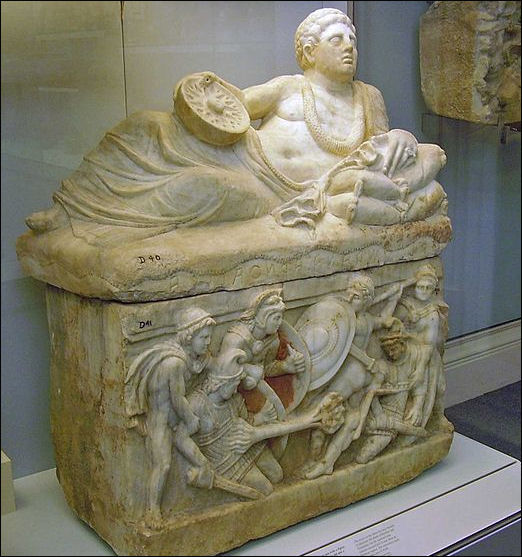
Cervterie, which embraces hundreds of acres of Banditaccai tombs, is the most impressive Etruscan necropolis discovered so far. At the mains are several circular tombs that a topped by piles of earth. Flanking these are several terraces of flat box-shaped tombs that are covered with bushes and trees. Most of the tombs have entrances.
In the Tomb of the Reliefs a model has been set up that depicts what the home of the a typical Etruscan dead person looks like. Hanging from carved rectangular pillars are axes, urns and knives. Around the burial chambers are carvings of three-headed dogs and hunters.
Etruscan Life
Etruscan statues show people with pointy ears and almond eyes.. They wore loose-fitting tunics and reclined on sofas.
The Etruscans lived in houses made from sun-dried mud brick and timber. They also lived in thatch roof huts and tile-roof houses on stone foundations. Their temples had terra-cotta bas-reliefs, tile roofs and decorative friezes.
The Etruscans were also expert horseman and superb oil lamp makers. Soldiers wore shoes made with laces and used bronze weapons. The Etruscan semicircular woolen cloak, draped over one shoulder, is the source of the Roman toga. The Etruscans also introduced the triumphal procession to celebrate military victories and ideas about art, architecture and religion to the Romans.

The world's oldest false teeth were found in Etruscan tombs dated at 800 B.C. Etruscans dentures were made from ivory, bone and teeth taken from dead people or oxen and held together with gold bridgework. The Etruscans were also regarded as the most skilled dentists in the ancient world.
Archeologist from the University of Florence are excavating a site in Tuscany named Masa Maritima that covered 75 acres and appears to have been a mining town where iron, copper, silver and tin were mined, Controlled by the powerful city of Vetulonia, the town was laid out in a rectangular grid. As of 2010 archeologists had excavated five residential quarters. Many of those houses had sandtstone foundations, walls made of sun-dried bricks and roofs covered with locally-made terra-cotta tiles similar to those still used in Tuscany today. Each quarter contained 10 houses and controlled one mine. There was also an industrial quarter just 30 kilometers from a lake where Etruscans smelted iron. Other ores were taken to different places to refine.
Among the artifacts that have been unearthed in Masa Maritime are vessels, dishes, grindstones, and tools related to wool and textile work, handicrafts usually associated with women. A site called Poggiarello Renzetti has revealed 100 iron nails used to make a second storey of a mud-brick building with a wood and clay upper floor. The house also contains a basement where foodstuffs were stored. .
Etruscan Women and Good Times
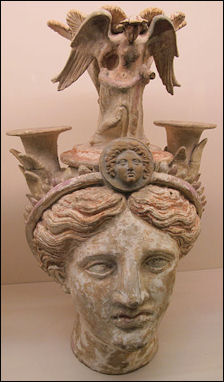 If Etruscan artwork accurately depicts how the Etruscans lived then they were clearly a people who enjoyed. Images in tombs include men using sling shots to hunt birds, naked boys diving, leaping dolphins and dancers strutting their stuff while giving the Texas longhorn hand sign. There are also paintings of lute-like stringed instruments and twin flutes, held in place in a musicians mouth by a leather strap.
If Etruscan artwork accurately depicts how the Etruscans lived then they were clearly a people who enjoyed. Images in tombs include men using sling shots to hunt birds, naked boys diving, leaping dolphins and dancers strutting their stuff while giving the Texas longhorn hand sign. There are also paintings of lute-like stringed instruments and twin flutes, held in place in a musicians mouth by a leather strap.
Figures of married couples displayed on sarcophagus showed a sensuality and tenderness that was not seen in Greek, Roman or even Renaissance art. Woman and men sat side by side at banquets, a fact that astonished the Romans, who considered the Etruscans hedonists.
Women had higher social status than their counterparts in Greece and Rome. They kept their own names (feminized versions of their father's names) and owned their own property. Tomb pictures depict them partying with males, participating in elaborate dinner parties, attending athletic contests, relaxing on couches and wearing expensive gold jewelry.
Scenes of dancing, feasting and music are found in tomb paintings at Tomba del Triclinio (around 470 B.C.) and Tomba delle Iscrizioni (around 520 B.C.) in Taraquina. The Tomb of the Lioness features two lions and dancers below a checkerboard ceiling.
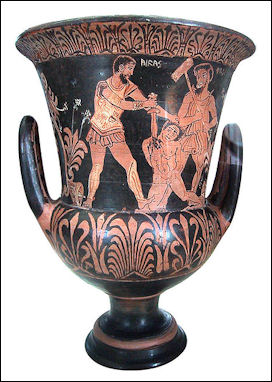 Work by Southern Methodist University at a site called Poggio Colla indicates that women may have participated in cult activities. A team led by archeologist Gred Warden found a tightly-packed deposit of 18 objects, half of which are gold, and include necklaces, pendants and semiprecious stones. Because they were found outside of tomb and many objects are associated with women the archeologists was surmised they might have been used by women in rituals.
Work by Southern Methodist University at a site called Poggio Colla indicates that women may have participated in cult activities. A team led by archeologist Gred Warden found a tightly-packed deposit of 18 objects, half of which are gold, and include necklaces, pendants and semiprecious stones. Because they were found outside of tomb and many objects are associated with women the archeologists was surmised they might have been used by women in rituals.Etruscan Cruelty
Etruscans could also be very cruel. There was a large population of slaves and serfs. They encouraged their pirates to practice cannibalism and tied prisoners face-to-face with corpses. Sometimes slaves and prisoners were sacrificed during the burials of kings.
Etruscans sport could quite violent. One contest illustrated on a tomb wall pitted a blindfolded man with a club against a fierce dog. Some scholars believe the Romans go their ideas for gladiator sports from the Etruscans.
The thumps up, thumbs down signs have been dated back to Etruria in 500 B.C. when the thumbs up sign was a signal to save a fighter's life in a battle and thumps down meant death. The Romans adopted the same signs for their gladiator battles.
Etruscan Art
Etruscan art includes monumental tombs, tomb paintings, painted vases, urns with reliefs, bronze mirrors, gold and silver jewelry and alabaster, terra cotta and limestone figurines.
The Etruscans produced great tomb art, bronzes and terra-cotta sculptures. The Etruscan Museum of Tarquinia has many fine pieces including a room full of magnificent sarcophagi topped by reclining figures and sometimes etched with puzzling epigraphs that scholars have had difficulty deciphering. There are also funeral urns and vases. The most beautiful vase is an imported one from Greece that contains an image of a woman's head with a beguiling expression.. Most of the prize pieces are at the Villa Giulia in Rome.

bull fresco
The Etruscans also made intriguing, highly-stylized narrow bronze figures that were offered as votive offerings at temples; realistic, detailed equestrian statues; lovely and distinct bucchero pottery, which were deliberately fired to look like metal.
There is evidence of monumental art, including bold reliefs and some of the earliest architectural terra cottas. The Etruscans built large acropolises and the largest buildings in Italy before the 6th century B.C. The only impressive monument left is the fortified city gate of Porta Augusta in Perugia from the second century B.C. Porta Augusta is also important in that it is one of the oldest places in Italy with an arch.
The Etruscans were among the leading importers of Greek vases. Some of the most beautiful Greek vases found by archaeologists have been unearthed at Etruscan sites.

Ivy wreath
National Etruscan Museum at Villa Giulia (Villa Borghese) in Rome is probably the finest Etruscan museum in the world. Among the treasures are a painted ostrich egg, imported from Africa but believed to have been painted in Etruria; a beautiful sarcophagus of married couple, which shows the husband gently caressing his wife on her arm and shoulder; a statue of a satyr with a taller woman doing a dance that bears an uncanny resemblance to the 1970s's dance, the bump; pair of wooden sandals imprinted with the owners toeprints; and a burial urn shaped like a thatched hut. Among the gold items are a necklace with two pendants of chubby woman's face and a third implanted with an onyx that looks like a human eyeball; and a broach decorated with a werewolf-like hoofed satyr with a is granulated background, an effect that jewelers today can't duplicate. The most important pieces are three gold tablets; two of which are inscribed in Etruscan and the third in Phoenician, the language of Carthage. The Etruscan language still hasn't been completely deciphered.
Archeological Museum in Florence has one of the best Etruscan collections outside of Rome's Villa Giulia. It contains Roman Etruscan pieces once housed in the Uffizi. One particularly amazing bronze statue shows a charging lion with a goat coming out of its back that in turn is being grabbed by the lion's tail which is a serpent. Also check out delightful Etruscan bronze of a boy's head and youth with the bare-breasted Demon of Death. The Egyptian
Etruscan Tomb Art
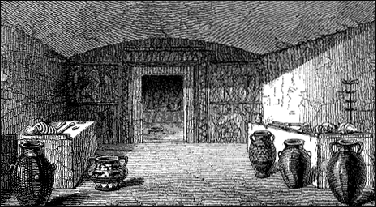 Tomb paintings include images of funeral ceremonies, athletic competitions, bloody duels, grand banquets, warriors and horsemen, demons and mythical creatures, and journeys to the next world. There are images of bearded snakes, dolphins, flocks of birds, musicians, wild dancers and jugglers. The vibrant colors were created with an array of pigments, some of them quite rare and expensive: white from calcite, red from hematite, black from charcoal, yellow from goethite, and blue from a mixture if silica, lime, copper and a special alkali imported from Egypt.
Tomb paintings include images of funeral ceremonies, athletic competitions, bloody duels, grand banquets, warriors and horsemen, demons and mythical creatures, and journeys to the next world. There are images of bearded snakes, dolphins, flocks of birds, musicians, wild dancers and jugglers. The vibrant colors were created with an array of pigments, some of them quite rare and expensive: white from calcite, red from hematite, black from charcoal, yellow from goethite, and blue from a mixture if silica, lime, copper and a special alkali imported from Egypt.
Few of the tombs with wall paintings are open to the public. Once a sealed tomb has been opened the paintings decays rapidly in the humidity. One tomb called the Tomb of the Leopards has beautiful wall paintings that depict nude wrestlers, men playing musical and a banqueting couple looking upon an egg, a symbol of immortality.
The Etruscan Museum in the Vatican contains one of the world's best collections of Etruscan art. The most outstanding pieces, which were found in Etruscan tombs in Tuscany and Lazio, include gold and silver jewelry, dice that looks just like modern dice, chariots, vase paintings, and small sarcophagi that held the cremated remains of wealthy Etruscans. Among the highlights are lovely Etruscan painting and a bronze statue of boy from the Etruscan site of Tarquina.
Etruscan Government, Infrastructure and Economics
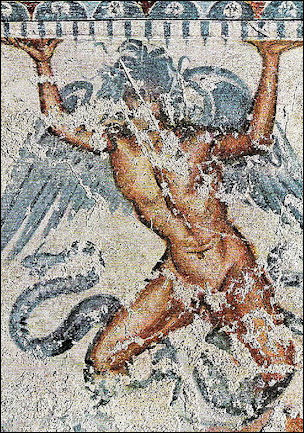 The Etruscans were governed under a lose confederation of city states, each controlled by oligarchies of the rich As was true in Greece, the Etruscans city states warred among themselves but were unable to unify against threats from the Romans and other peoples.
The Etruscans were governed under a lose confederation of city states, each controlled by oligarchies of the rich As was true in Greece, the Etruscans city states warred among themselves but were unable to unify against threats from the Romans and other peoples.
The Etruscans according to the Romans were masterful engineers and planners. Their cities were arranged in grid like blocks. Archaeological excavations have revealed fortifications, public buildings and temples. There is also evidence of urban planning. Some cities were laid out with separate zones for industry, residences and public housing.
The Etruscans built advanced roads with ruts of paved stones of wagon wheels, and grids of streets and sophisticated underwater passages. They used a surveying device called a groma to build roads. In the 6th century Etruscan kings built some of the first streets, temples and water systems in Rome.
The Etruscans built sewers and drained the land that now makes up central Rome. They drained the swamp that later was the site of the Roman Forum and laid the foundation for the city's sewer system. They may have taught the Romans how to make aqueducts and sewers.
The Etruscans were mostly farmers. Archaeological excavations have revealed artisan's workshops and kilns. They were also master sailors and traders. They traded throughout the Mediterranean, with Carthage in North Africa and Greece and its colonies. The Etruscans prized amber and traded with the Baltic region to get it. They also traded with but were suspicious of the Greeks who resided in colonies in southern Italy.
The Etruscans mined iron, copper and tin ore and traded these metals for perfume, ivory, amber and fine ceramics from Egypt, Greece and Phoenicia. Slaves were used as miners. The metal was worked in factories near the mine. Slag heaps from one their mine in Elba were mined by the Italians in World War I and II. Metal was traded with the Greeks for ceramics used in Etruscan tombs.
End and Legacy of Etruscans
By the 4th century B.C., Etruscan tomb art became dark. Pleasant scenes of parties and games became replaced with ones of violent battles and vicious creatures. There has been a great deal of debate among scholars as to whether this reflected a change in beliefs about the afterlife or a change in political or economic condition in Etruria or something else.
The Etruscan Civilization ended when it was overrun by Rome. The Romans besieged the Etruscan city states for 130 years before finally overcoming the last one, Velzna, in 265 B.C. Some scholars blame the Etruscan demise on their inability to change and adapt to challenges such as population growth, economic hardships and threats from their neighbors. Others blame the Etruscan demise on their failure on the Etrsucan towns and cities to unite into a single powerful state and their rigid class system.

Many Etruscan mining towns were suddenly abandoned at the end of the 6th century B.C. Most scholars think this was the result of an economic crisis such as a sudden decline in the profitability of mining but some think that industrial pollution and arsenic poisoning may have been the cause.
The Etruscans were instrumental in introducing Greek culture and the Greek alphabet to Rome. Their love of luxury also appears to have been passed on to the Romans.
The Tyrrhenian Sea on the west coast of Italy is named after the name the Greeks gave the Etruscans. The Adriatic is named after the Greco-Etruscan city of Adria. Tuscany is a Latin corruption of Etrusci, the name the Romans gave to the Etruscans.
The largest Etruscan settlement every found, a 7th century town covering at least 75 acres, was founded on the Tuscan plain near Lake Accessa. Archaeologists were so excited about the wealth of information obtained from the site the have called it the Etruscan Pompeii.
Image Sources: Wikimedia Commons, The Louvre, The British Museum
Text Sources: New York Times, Washington Post, Los Angeles Times, Times of London, Yomiuri Shimbun, The Guardian, National Geographic, The New Yorker, Time, Newsweek, Reuters, AP, Lonely Planet Guides, Compton's Encyclopedia and various books and other publications. Most of the information about Greco-Roman science, geography, medicine, time, sculpture and drama was taken from "The Discoverers" [∞] and "The Creators" [μ]" by Daniel Boorstin. Most of the information about Greek everyday life was taken from a book entitled "Greek and Roman Life" by Ian Jenkins from the British Museum [||].
No comments:
Post a Comment